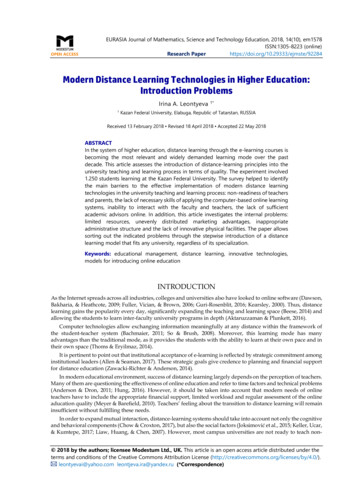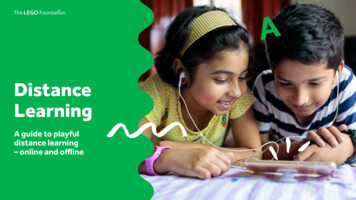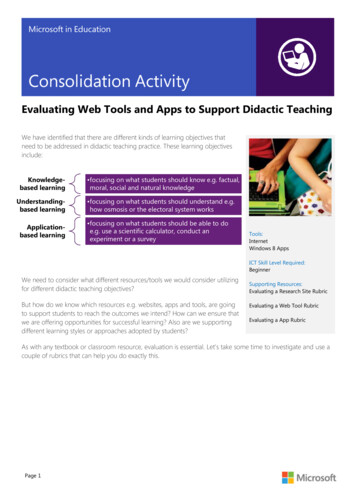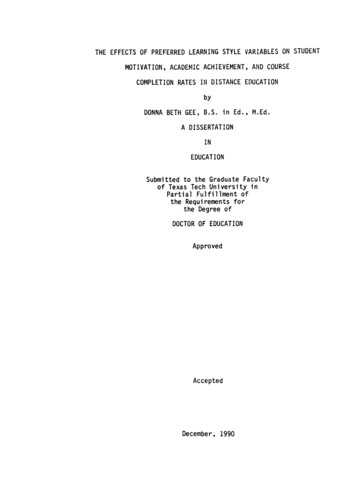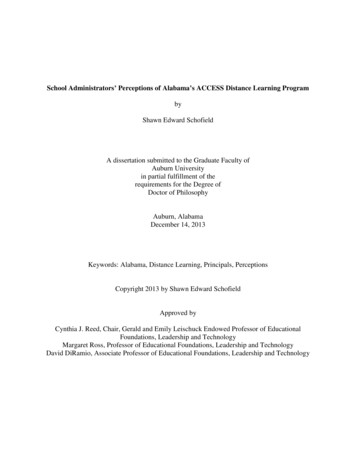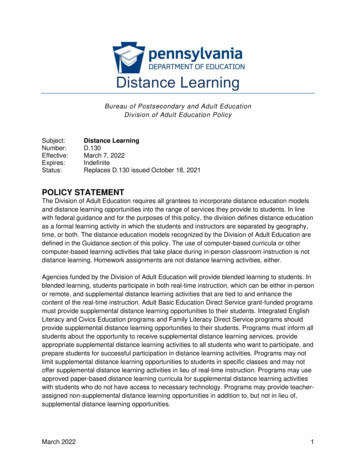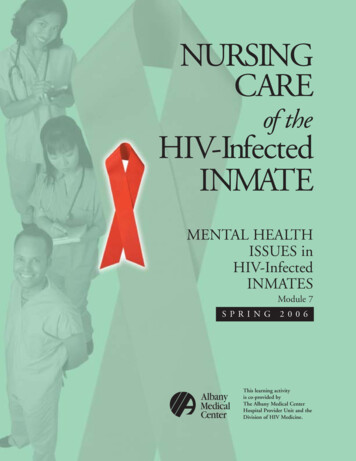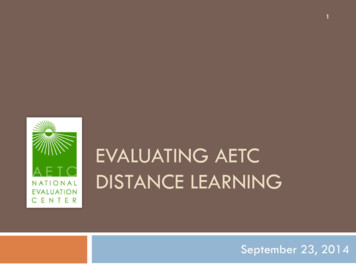
Transcription
1EVALUATING AETCDISTANCE LEARNINGSeptember 23, 2014
Agenda2 Part I: Distance learning literature review Part II: AETC Telehealth center evaluation Background Clinicianand purposeand clinic questions Preliminary Conclusionsresults of FY 12-13 data
3Part I: Distance LearningLiterature Review
Objective and Method4 Objective: Examine the literature on strategies usedto evaluate distance learning (DL)Methods: Used several different search enginesand a host of key words including: evaluation,distance learning, continuing medical education
5Distance LearningLiterature Review Results
Traditional and Distance Learning Taxonomy6TermDefinitionTraditional teachingDelivering teaching face to face, typically in a classroom settingDelivering teaching to learners who are not physically present.Distance learningAlso called eLearning, online learning, or Internet-basedlearningComputer-assisted instruction, web-based educationTechnology-assisted educationsimulation, and virtual reality technologiesThe use of telecommunication and information technologies toprovide clinical health care at a distance, to eliminate distanceTelemedicinebarriers, and improve access to medical services that are notavailable in rural communities.Health-related services and information delivered viatelecommunications. Telehealth is an expansion of telemedicineTelehealthwhich also encompasses preventive, promotive, and curativeaspects.An approach that combines distance learning with traditionalBlended learninginstructor-led training e.g., a lecture is supplemented by anonline tutorial
Results: Benefits of Distance Learning7 Easy accessFlexible timingAbility to meet different learning stylesInteractivityNot bound by geographyCost-effective
Results: Effectiveness of Distance Learning8Meta-analysis of 76 studies comparing internetbased vs. traditional teaching interventions showedminor differences.“neither inherently superior or inferior to traditionalinstruction; rather they are different andcomplementary” Though methods appear to be equal, they are notnecessarily interchangeable. Cook DA, Levinson AJ, Garside S, Dupras DM, Erwin PJ, Montori VM. Internetbased learning in the health professions: A meta analysis. JAMA2008;300(10):1181-1196
Results: Effectiveness of Distance Learning9Effective instructional design includes: Interactivity Practice exercises Repetition FeedbackSiemens, George. Instructional Design in Elearninghttp://www.elearnspace.org
Results: Key Research Areas10 When and how to best use distance learning? Synchronous or asynchronousWhat are the best interface design variables? Navigation Learnability Accessability Consistency Visualdesign
11Kalet, AL, Song, HS, Sarpel, US, Schwartz R, Brenner J, Ark TK, Place J. Just enough, but not too muchinteractivity leads to better clinical skills performance after a computer assisted learning module.Med Teach. 2012;epub ahead of print. PMID: 22917265.Cook DA, Thompson WG, Thomas KG, Thomas MR, Pankratz VS. Impact of self-assessment questionsand learning styles in Web-based learning: a randomized, controlled, crossover trial. Acad Med.2006 Mar;81(3):231-8. PubMed PMID: 16501263.Jwayyed S, Stiffler KA, Wilber ST, Southern A, Weigand J, Bare R, Gerson LW. Technology assistededucation in graduate medical education: a review of the literature. Int J Emerg Med. 2011 Aug8;4:51.Casebeer L, Kristofco RE, Strasser S, Reilly M, Krishnamoorthy P, Rabin A, Zheng S, Karp S, Myers L.Standardizing evaluation of on-line continuing medical education: physician knowledge, attitudes,and reflection on practice. J Contin Educ Health Prof. 2004 Spring;24(2):68-75. PubMed PMID:15279131.Cook, DA. If you teach them, they will learn: why medical education needs comparative effectivenessresearch. Adv in Health Sci. 2012a;17;305-310.Freire, L L. A literature review about usability evaluation methods for e-learning platforms. Work.2012;41, 1038-1044.Cook DA, Dupras DM. A practical guide to developing effective web-based learning. J Gen InternMed. 2004 Jun;19(6):698-707. Review. PubMed PMID: 15209610; PubMed Central PMCID:PMC1492389.Sandars J, Lafferty N. Twelve Tips on usability testing to develop effective e-learning in medicaleducation. Med Teach. 2010;32(12):956-60. PubMed PMID: 21090948.
12Questions?Comments?
13Part II: AETC Telehealth CenterEvaluation
Telehealth Center background14 In 2011, the Northwest AETC, Pacific AETC, andPennsylvania/Mid-Atlantic AETC collaborated with theAETC NEC to develop a cross-region evaluation of theirTelehealth programs Providerevaluation and clinic-level patient-careindicators were developed From July 2012-June 2013,this program expanded tonine funded Telehealthcenters across the country
Telehealth Centers in 201315 AETC Capitol Region Telehealth ProjectNorthwest AETC Extension for Community Healthcare Outcomes(ECHO) Pacific AETC HIV Learning Network Telehealth AETC Appalachian Project (TAAP) Tri-State Telehealth Advancement Network HIV Health Education Assessment Research Telehealth (HEART) Florida/Caribbean Telehealth Education Training Center Mountain-Midwest HIV Telehealth Initiative Southern Central AIDS Education Telehealth Training Center
Telehealth Center Purpose16 Telehealth Center Trainings: Targetproviders serving patient populations in ruraland low HIV prevalence regions Useinnovative patient outreach methods, such astelemedicine This multi-site evaluation focuses on: Provider Patientself-efficacycare change at the clinic level over time
Data Collection17 Standard process data collected for each trainingon the Participant Information Form (PIF) and EventRecord (ER) formSpecial AETC codes (50-58) for Telehealth eventsEvaluation data collected annually, one year afterthe initial Telehealth training event Measurement Preof longitudinal outcomesand Post measures available for 3 regions
Telehealth Center Events18 AETC codes (50-58) used by funded-TelehealthCenters on ER forms:Howard University 54 Northwest AETC 52 Pacific AETC 50 Pennsylvania Mid-Atlantic 51 South Carolina Research Foundation 58 University of Arkansas for Medical Sciences 55 University of Colorado Denver 56 University of Kentucky Research Foundation 53 University of South Florida 57
19Telehealth Cross-Site EvaluationQuestions
Telehealth Cross-Site Clinician Questions20 ACRE Immediate-Post knowledge change question Howwould you rate your level of knowledge about thiscontent before the AETC Telehealth Project?(Retrospective pre-post question)(Novice) 1—— 2 —— 3 —— 4 —— 5 (Expert) Howwould you rate your level of knowledge about thiscontent after the AETC Telehealth Project? (Retrospectivepre-post question)(Novice) 1—— 2 —— 3 —— 4 —— 5 (Expert)
Telehealth Cross-Site Clinician Questions21 Provider Self-Efficacy: As a result of my involvement in the AETC Telehealth Project,I feel more capable in the clinical management of HIVdisease1(Cannot do at all) to 10 (Highly certain can do) Optional Question: As a result of my involvement in AETC Telehealth Project, Ifeel more able to offer HIV testing and preventioncounseling in my clinical practice1(Cannot do at all) to 10 (Highly certain can do)
Telehealth Cross-Site Clinic Questions22 Patient Care Indicators: 1.HIV Testing: 1a.Total number of patients aged 13-64 with atleast one visit in the calendar year prior to the firsttelehealth training/consultation 1b.Among patients included in 1a., the number whoreceived HIV testing 1c.Among patients included in 1b., the number whotested positive for HIV(cont.)
Telehealth Cross-Site Clinic Questions23 2. Patients in Care Thenumber of HIV-infected patients with at least onevisit in the calendar year prior to the first telehealthtraining/consultation 3. CD4 Count Monitoring AmongHIV patients in care, the number of patientsreceiving at least 2 CD4 tests in the last 12 months 4. VL Monitoring AmongHIV patients in care, the number of patientsreceiving at least 2 VL tests in the last 12 months
24FY12-13 Telehealth CenterFindings:Trainings and Trainees
25Telehealth Center Training and TraineeCharacteristics Trainings: There were 251 AETC Telehealth-fundedtraining events in FY12-13 occurring at 9 TelehealthCenters There was a mean of 7.8 (range: 1-27) participants at eachFY12-13 Telehealth events (based on number of PIFs)Trainees: There were 1,676 Telehealth PIFs completed Among these records, there were 1,635 linked ER-PIFrecords with a valid PIF ID There were 351 unique Telehealth trainees de-duplicatedby AETC and PIF ID.Data source: Cross-region ER and PIF data FY 12-13
Telehealth Center Repeat Trainees26 Repeat trainees: Over half of these Telehealthtrainees (n 205; 58.4%) attended at least oneother AETC training of any type during the fiscalyear Amongthese repeat trainees, the mean number ofTelehealth Center trainings attended was 7.3 (range: 142)Data source: Cross-region ER and PIF data FY 12-13
27FY12-13 Telehealth Center Trainingsby Region (N 251)AETC Region[52] Northwest[57] Florida/Caribbean[51] Pennsylvania/Mid-Atlantic[55] U. of Arkansas for Medical Sciences[50] Pacific[56] Mountain Plains[58] Southeast[53] University of Kentucky[54] Howard UniversityData source: Cross-region ER data FY 4.84.0
28FY12-13 Telehealth Center TrainingModalityTraining modalityMixed modesSingle modesChart/case review onlyComputer-based onlyLecture/Workshop onlyWebcast/Webinar onlyConference-call/Telephone onlyTelemedicine onlyClinical preceptorship onlyRole Play onlySelf-study onlyUnspecified modeData source: Cross-region ER data FY 0.00.08.4
29FY12-13 Telehealth Center TrainingMode TypeDistance In-personn 59 (23.5%)n 34 (13.6%)Both modesn 137 (54.6%)Mode not specified for n 21 (8.4%) Telehealth trainings.Distance mode includes computer-based, conference call, telemedicine, webcast/webinar.In-person mode includes chart/case review, clinical preceptorship, lecture/workshop, role play.Data source: Cross-region ER data FY 12-13
30FY12-13 Telehealth Center TrainingTopic Coverage (N 251)Event Record Topic Coverage(ER question 4)ER topicnumbersincludedNtrainings%Clinical Management#1-1620983.3Health Care Organization and DeliveryIssues#17-2810441.4Prevention and Behavior Change#29-316726.7Psychosocial Issues#32-3310341.0Targeted Populations#34-4410441.4 A mean of 8 topics were covered at Telehealth events(SD 6.1; range: 0-29).Topic coverage not mutually exclusive.Data source: Cross-region ER data FY 12-13.
31FY12-13 Telehealth Center TrainingCharacteristics (N 251) Over half of the Telehealth trainings (n 127;50.6%) had Minority AIDS Initiative funding. No other funding initiatives were indicated.Collaborations included: OtherAETCs (n 30; 12.0%) Othertraining centers (n 5; 2.0%) Otheragencies (n 18; 7.2%)Data source: Cross-region ER data FY 12-13
32FY12-13 Telehealth Center TraineeRace/Ethnicity (N %White(n 216)Black(n 68)Hispanic(n 22)10.0%Other(n 35)Other includes American Indian or Alaska Native, Asian, Native Hawaiian or Other Pacific Islander, and Multiracial.Unknown race/ethnicity (n 10) not shown but included in calculation.Data source: Cross-region ER-PIF data FY 12-13. Last record included among repeat trainees.
33FY12-13 Telehealth Center TraineePrincipal Employment Setting (N 351)Top 10 Principal Employment SettingsCommunity Health CenterAcademic Health CenterState/Local Health DepartmentRural Health ClinicPrivate PracticeHospital/ERCommunity-Based OrganizationCorrectional FacilityHIV ClinicHospital-Based .64.03.73.1Other settings, unspecified and not applicable (because not working) (n 37) not shown but included in calculation.Data source: Cross-region ER-PIF data FY 12-13. Last record included among repeat trainees.
34FY12-13 Telehealth Center TraineePrimary Employment Setting (N al(n 166)Suburban/urban(n 174)Unspecified and not applicable (because not working) (n 11) not shown but included in calculation.Data source: Cross-region ER-PIF data FY 12-13. Last record included among repeat trainees.
35FY12-13 Telehealth Center TraineePatient Population (N 1%None*(n 114)1-24%(n 99)25-49%(n 46)7.4%50-74%(n 26)HIV Racial/Ethnic Minorities Served in Past Year*None includes those who do not provide direct HIV services.Unspecified (n 18) not shown but included in calculation.Data source: Cross-region ER-PIF data FY 12-13. Last record included among repeat trainees.13.7% 74%(n 48)
36FY12-13 Telehealth Findings:Evaluation
FY12-13 Self-Reported Knowledge RatingBefore and After Telehealth Project37(Expert) 100755065.948.225(Novice)0Knowledge BeforeResponses re-scaled from 1-5 to 0-100.Data source: Cross-region Telehealth IP data FY 12-13.Knowledge After
FY12-13 Reported Provider Self-EfficacyAfter Telehealth Project38(Highlycertaincan do)1007573.979.05025(Cannotdo at all)0PSE: Clinical ManagementResponses re-scaled from 1-10 to 0-100.Data source: Cross-region Telehealth IP data FY 12-13.PSE: HIV Testing
39FY12-13 Telehealth Clinic IndicatorResults (1a) – HIV Testing1a. Total number of patients aged 13-64 withat least one visit in the calendar year prior tothe first Telehealth training/consultationMean total number ofpatients 713,244Mean difference: -813p-value 0.31% difference: -5.8%PrePostLimited to Telehealth Centers with Pre and Post data available: Northwest AETC ECHO, Pacific AETC HIV Learning Network,and TAPP. Data source: Cross-region Telehealth IP data FY 12-13.
40FY12-13 Telehealth Clinic IndicatorResults (1b) – HIV Testing 1b. Among patients included in 1a., the numberwho received HIV testingMean number of patients1,4001,1791,2001,000800600400Mean difference: 732p-value 0.36% difference: 163.7%4472000PrePostLimited to Telehealth Centers with Pre and Post data available: Northwest AETC ECHO, Pacific AETC HIV Learning Network,and TAPP. Data source: Cross-region Telehealth IP data FY 12-13.
41FY12-13 Telehealth Clinic IndicatorResults (1c) – HIV Testing 1c. Among patients included in 1b., the numberwho tested positive for HIVMean number of patients3.53.23.02.52.02.0Mean difference: 1.2p-value 0.33% difference: 61.1%1.51.00.50.0PrePostLimited to Telehealth Centers with Pre and Post data available: Northwest AETC ECHO, Pacific AETC HIV Learning Network,and TAPP. Data source: Cross-region Telehealth IP data FY 12-13.
42FY12-13 Telehealth Clinic IndicatorResults (2) – Patients in CareMean number of patients The number of HIV-infected patients with at leastone visit in the calendar year prior to the firsttelehealth training/consultation807060504030201007271Mean difference: -0.9p-value 0.84% difference: -1.3%PrePostLimited to Telehealth Centers with Pre and Post data available: Northwest AETC ECHO, Pacific AETC HIV Learning Network,and TAPP. Data source: Cross-region Telehealth IP data FY 12-13.
43FY12-13 Telehealth Clinic IndicatorResults (3) – CD4 Count Monitoring Among HIV patients in care, the number of patientsreceiving at least 2 CD4 tests in the last 12 monthsMean number of patients706062595040Mean difference: -3.2p-value 0.74% difference: -5.2%3020100PrePostLimited to Telehealth Centers with Pre and Post data available: Northwest AETC ECHO, Pacific AETC HIV Learning Network,and TAPP. Data source: Cross-region Telehealth IP data FY 12-13.
44FY12-13 Telehealth Clinic IndicatorResults (4) – VL Monitoring Among HIV patients in care, the number of patientsreceiving at least 2 VL tests in the last 12 monthsMean number of patients706061605040Mean difference: -0.6p-value 0.94% difference: -0.9%3020100PrePostLimited to Telehealth Centers with Pre and Post data available: Northwest AETC ECHO, Pacific AETC HIV Learning Network,and TAPP. Data source: Cross-region Telehealth IP data FY 12-13.
Telehealth Center Evaluation Summary45 Telehealth center evaluation approach differed from othercross-site training evaluationsMajority of trainings delivered through mixed modes,combining distance and in-person methodsAbout half of the trainees practiced in rural settingsTrainees self-reported greater knowledge and self-efficacyafter the Telehealth Center trainingFor longitudinal patient care indicators, higher meannumbers reported in the following year for HIV testing andpositivity among the 3 Telehealth centers with Pre and Postdata available None of the clinic indicators were significantly differentData source: Cross-region ER and PIF data FY 12/13
Conclusion46 As discussed during the Lit Review, numerousbenefits of distance-based learning: Easy Notaccessbound by geography Flexible timingThere were some improvements More Wedata is coming in and needs to be analyzedrecommend continuing with Telehealth Centerinitiatives
Future analyses47 Explore additional questions: Aresome trainings or topics more effective in personrather than remotely? Additional Telehealth Center Post data will bereceived Preliminaryfindings on patient care clinic indicatorsbased on 3 centers AnalysesCenterswill be expanded to include all Telehealth
48Questions?Comments?
49Thank you!
Also called eLearning, online learning, or Internet -based learning . Technology-assisted education : Computer-assisted instruction, web -based education simulation, and virtual reality technologies . Telemedicine : The use of telecommunication and information technologies to provide clinical health care at a distance, to eliminate distance
